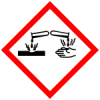The Producer has a plan to phase out by 2024 pesticides listed in category 2 of the Globally Harmonized System of Classification and Labelling of…
Coalition status
BCI Phase out by 2024
Fairtrade Red
This list contains 207 pesticides. The list is valid as of January 2018.
Prohibited pesticides that must not be used on Fairtrade products under any…
FSC highly restricted HHPsChemical pesticide presenting two or three out of the following hazards: acute toxicity, chronic toxicity and environmental toxicity.
GCP ProhibitedPesticides in the Prohibited List are not used.
This includes pesticides that are:
Listed under the Stockholm Convention, Rotterdam Convention or…
UTZ WatchlistUTZ Watchlist is composed of active ingredients that are not banned but that have a potentially severe and/or cumulative risk for human health and/or…
Details
Type: Pesticide
Use: Acaricide
Example applications: Fruit including apples, pears, strawberries, grapes, citrus;Egg plant
Example pests controlled: Mites including spider mites, citrus mites, bulb mites, tomato-russet mite
Mode of action: Contact action. Inhibits oxidative phosphorylation. Inhibitor of mitochondrial ATP synthase.
Source: PPDB
Toxicty
Bird toxicity
Highly toxic to birds acute oral LD50 (LD50 < 200mg/bg bw)
Highly toxic to birds acute oral LD50 (LD50 < 200mg/bg bw)
Fatal if inhaled (H330)
Fatal if inhaled
Mammal toxicity
Acute oral LD50 for most sensitive mammal species (LD50 < 200mg/kg bw).
Identifiers
GHS safety labels
About Globally Harmonized System of Classification and Labelling of Chemicals (GHS)
From Wikipedia: The Globally Harmonized System of Classification and Labelling of Chemicals (GHS) is an internationally agreed-upon standard managed by the United Nations that was set up to replace the assortment of hazardous material classification and labelling schemes previously used around the world. Core elements of the GHS include standardized hazard testing criteria, universal warning pictograms, and harmonized safety data sheets which provide users of dangerous goods with a host of information. The system acts as a complement to the UN Numbered system of regulated hazardous material transport. Implementation is managed through the UN Secretariat. Although adoption has taken time, as of 2017, the system has been enacted to significant extents in most major countries of the world.[1] This includes the European Union, which has implemented the United Nations' GHS into EU law as the CLP Regulation, and United States Occupational Safety and Health Administration standards.
- H301

Toxic if swallowed
Class: Acute Toxicity
Subclass: Oral - H315

Causes skin irritation
Class: Corrosion/irritation
Subclass: Skin - H318

Causes serious eye damage
Class: (Corrosion)Damage/irritation
Subclass: Eye - H330

Fatal if inhaled
Class: Acute Toxicity
Subclass: Inhalation - H335

May cause respiratory irritation
Class: STOT-respiratory irritation
Subclass: Single exposure - H400

Very toxic to aquatic life
Class: Aquatic
Subclass: Acute - H410

Very toxic to aquatic life with long lasting effects
Class: Aquatic
Subclass: Chronic
